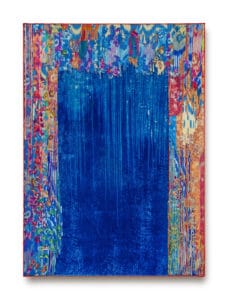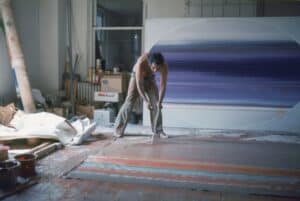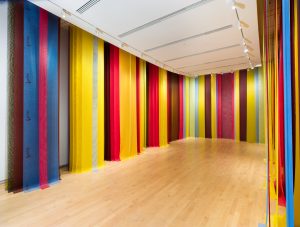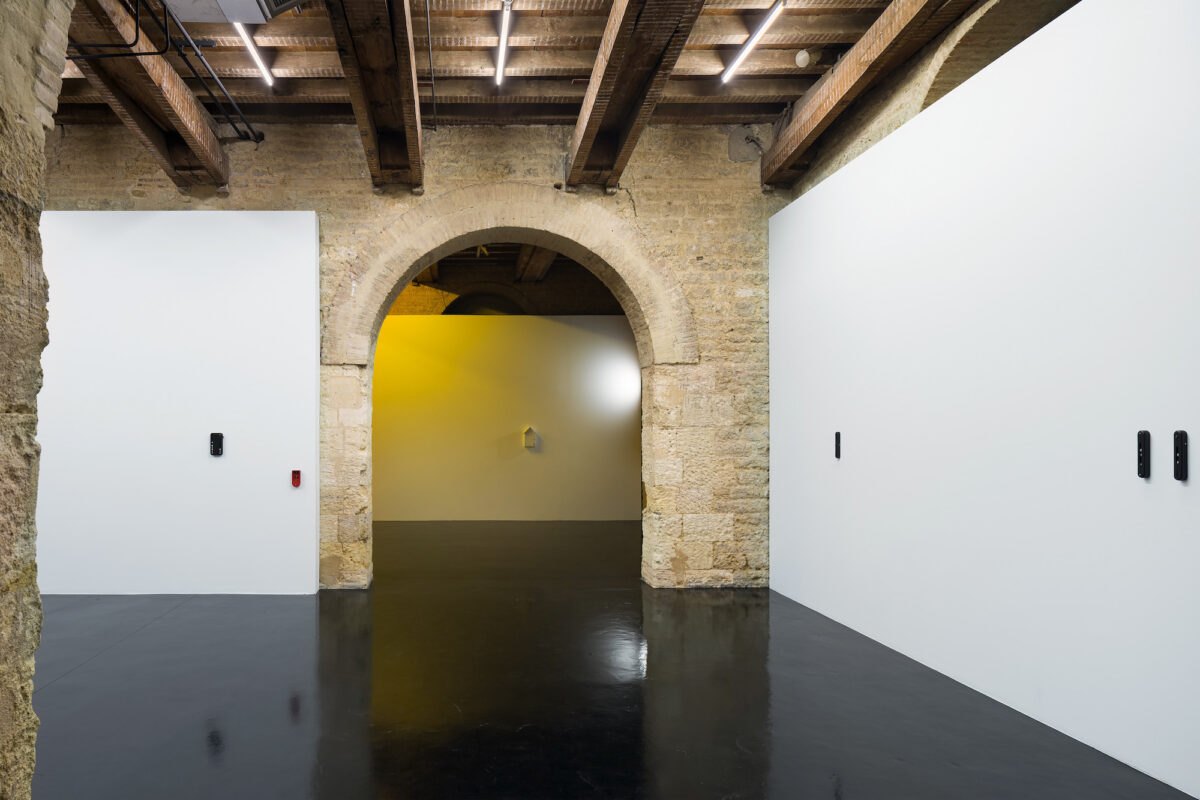
To think about Maxmine Bichon’s first institutional exhibition analogously, I will begin with a quote from Tracy Chevalier’s novel Girl With A Pearl Earring; specifically, a moment in the narrative when the protagonist Griet is describing a painting by Johannes Vermeer to her blind father:
‘…When you look at the cap long enough,’ I added hurriedly, ‘you see that he has not really painted it white, but blue, and violet, and yellow.’
‘But it’s a white cap, you said.’
‘Yes, that’s what is so strange. It’s painted many colours, but when you look at it, you think it’s white.’ […] I wanted him to understand that white was not simply white.”
Subtly woven through the fabric of Capc – Musée d’Art Contemporain de Bordeaux, Bichon’s exhibition La poursuite [The chase] is a journey into all that is ‘not simply white.’ Working iteratively, through architectural interventions — the removal of walls, atmospheric changes in the museum’s lighting and careful adaptions to its standardised signage — as well as through sculptural adornments and the presentation of a newly penned cartoon, this chase feels oddly cocoon-like, a spatial state in-between or something of a mise-en-abîme — a reflection of and on itself wrapped up with and in itself. The final chapter in a tetralogy of exhibitions, held in Corrèze (France), Rome (Italy) and Athens (Greece), The chase structurally alludes to Bichon’s belief that ‘the places we pass through transform us.’ And, as the title suggests, it is this affective process of moving through that Bichon attends to, asking us to linger and look closely to discover the multi-tonal make up of things.
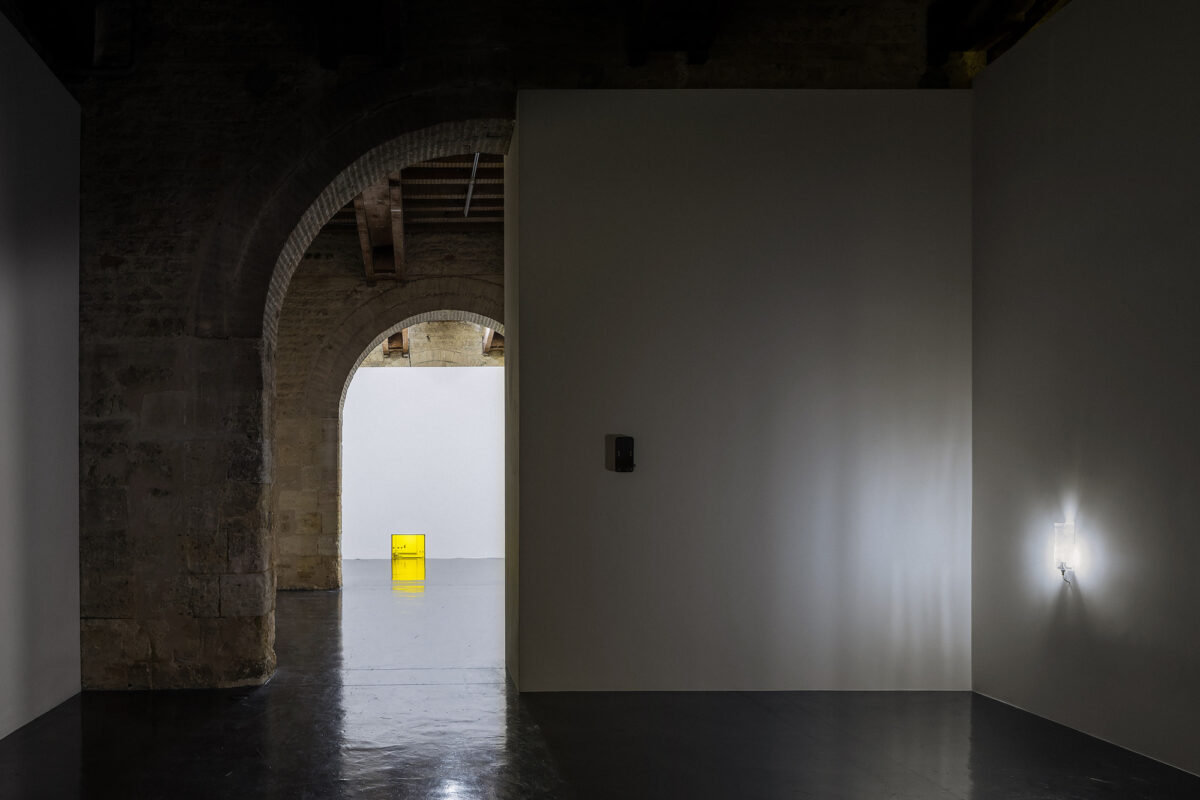
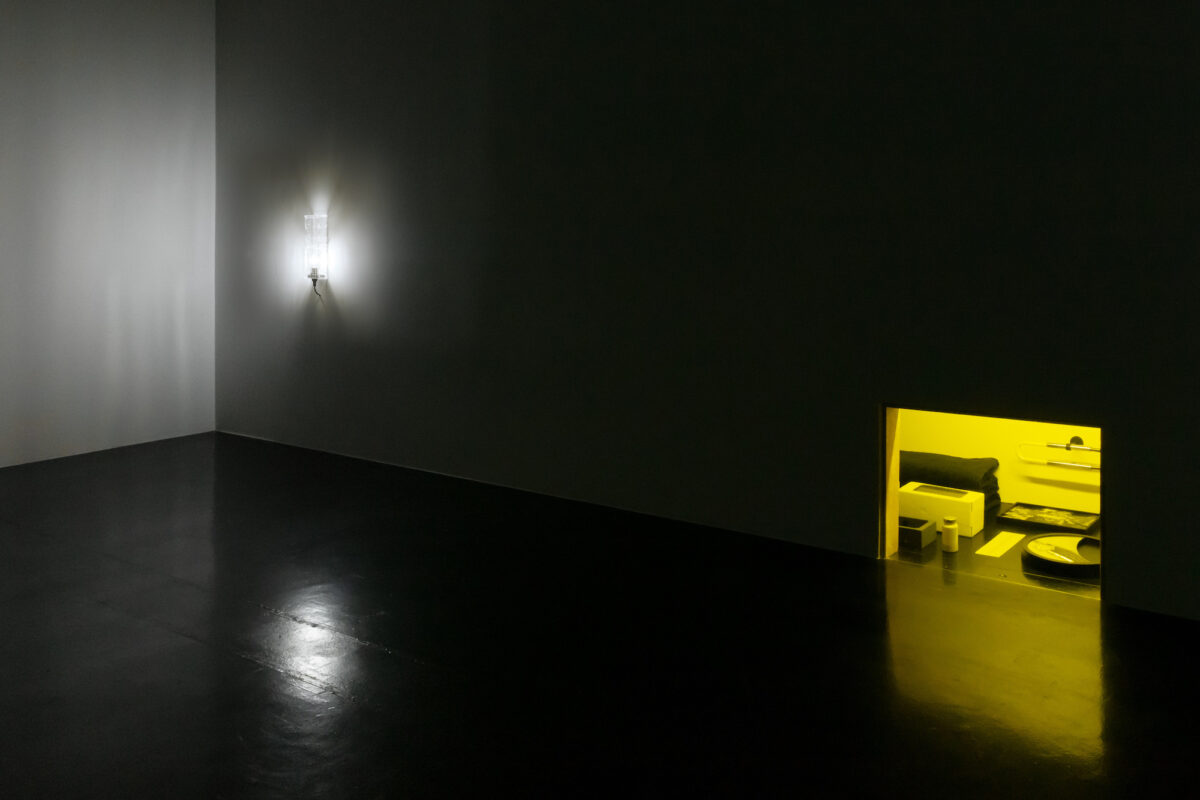
And so I enter The chase. First, a violet-hued void, a space on the verges of night and day or day and night, a room which Bichon makes soft by dimming Capc’s museal lighting. Dwelling in this dark, my eyes are drawn low. Crouched on my knees, head turned and eyes stretching, agape, I peer through a square of sherbert-yellow Plexiglas emanating light from the base of an otherwise white wall. I crouch, head turned with eyes agape, and, as I peer through this archival pain I witness something of the exhibition’s entrails. Materially, Les souffleurs (2023) is an architectural cut, a vitrine-like window which allows me to peep inside Capc’s wall cavities and to view the new foundations Bichon has set within. A gesture exposing what constitutes the exhibition’s simple white skin, Les souffleurs repeats three times throughout The chase. Again and again, peeping and peering into the work’s yellow glows I see an array of monochrome objects — an empty box and a folded towel, a framed photo of a veined caterpillar, a white pill bottle with a black lid screwed on tight, a scroll of poetry or something similar, a sleepy-eyed wolf sticker affixed to a crescent moon mirror, a cage, a box, a number of boxes white and black and grey, a pillow, what looks like a high modernist light fitting, academic papers, a poster, jumper, a three spouted spinning teapot (and I am probably missing a whole load of things) — all precisely arranged within these non-spaces. More than a random collection of detritus, each of the items displayed in these chambers comes from one of the exhibitions which prelude The chase. Presented without a fixed narrative or context, these quasi-archaeological records not only invite quizzical intrigue — Why a wolf sticker? — but formally suggest how the foundations for this exhibition’s existence lie elsewheres — in Corrèze, in Rome, and in Athens.
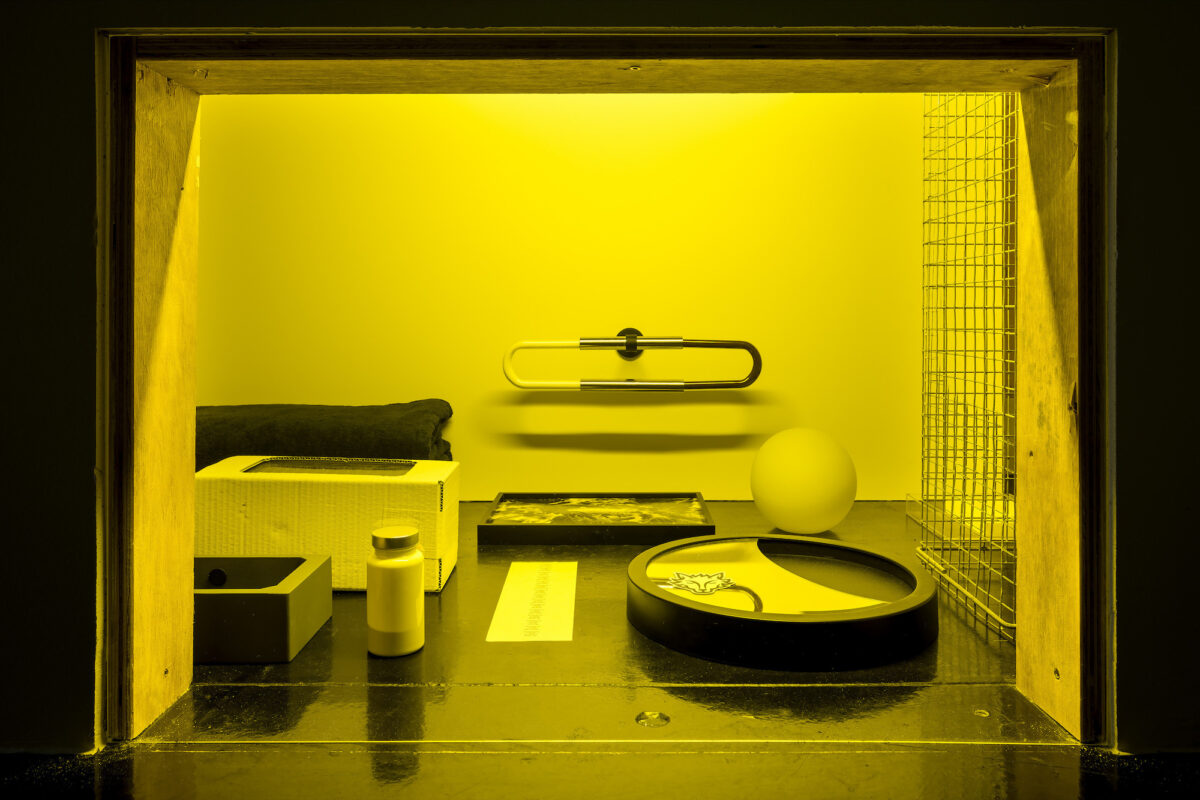
A recurring theme grounding The chase is theidea of metamorphosis. This poetic and philosophical state is sighted, and cited, throughout via caterpillar metaphors. Specifically, this creature’s journey through cocoon-hood, emerging as a moth or butterfly. As the objects of Les souffleurs rest comfortably within their silk-lit wall shelters, they suggest something of this buggy transfiguration. Crucially, the work(s) demonstrates how, rather than being lost when entering into a process of metamorphosis, threads from a past always already co-form a present, enlightening a future in turn.
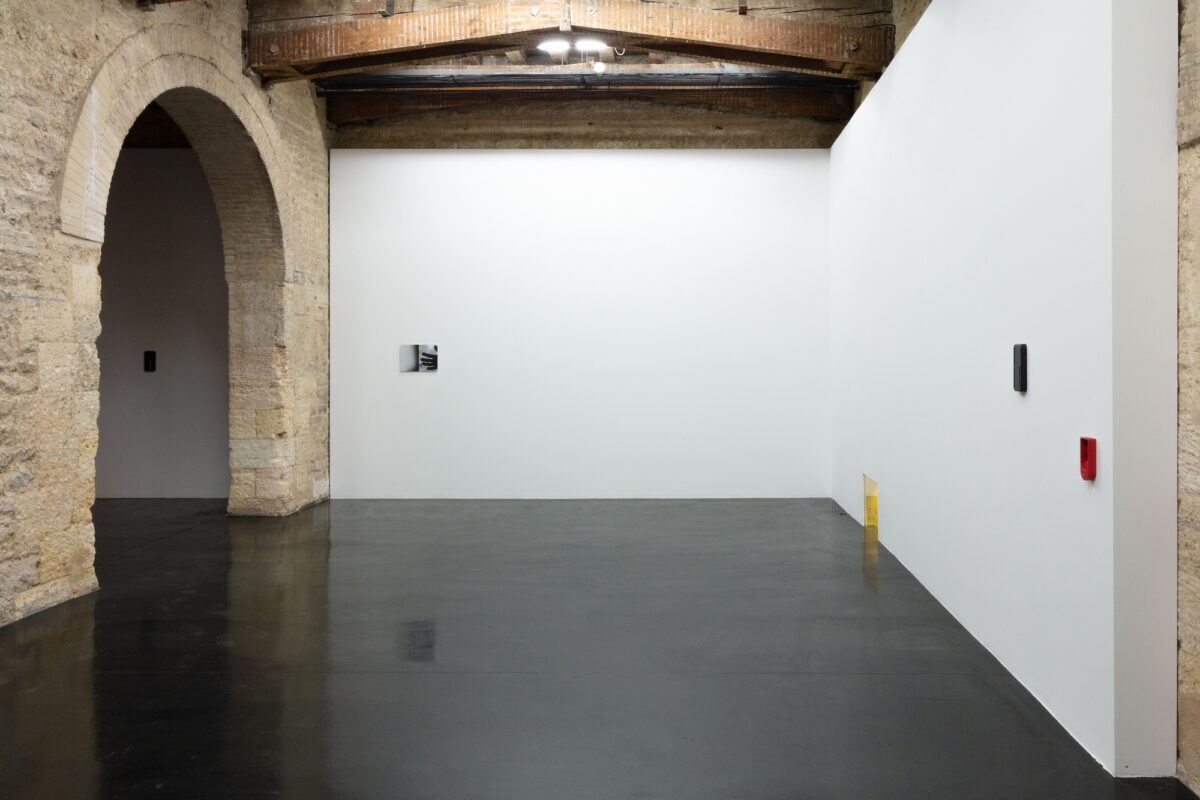
Working with and in-between the possibilities afforded through this buggy metaphor, jumping between caterpillar-past and mothy-future, at Capc Bichon’s interest lies in how things can form and reform differently if provided the opportunity or a shift in context, be that solid or more atmospheric. Moving about the exhibition, as dim violet breaks into March daylight then a sleeping light once more before entering a room stained that vivid yellow, the iterative series of sculptural works titled Financiers (2023) give a sensible form to this interest. Cutely surreal and bug-eyed, these wall-based objects are each composed from a common set of parts; as unique forms however each iteration of Financiers has a different arrangement of these components. Generally, each sculpture is an eggshell grey box with rounded corners and oblong holes that house beady rows of chalk-white marbles; each has a petits fours like presence with bodies perforated by bare coin appendages and they are all decoratively held together with the cutest of blue-chrome screws. Hung like individual moths, or like the dusty dots which dapple moth wings, throughout the exhibition’s differently lite rooms, these sculptures calmly point to how a named Thing is always plural and porous, transfigured with and by a context or the logic of a surround. (It is perhaps important to note that the title of the work alludes to this sense of how a Thing can change depending on an association or context. Financiers (noun) has at least two meanings: financiers, small French almond cakes; financier, a person concerned in the management of large amounts of money.)

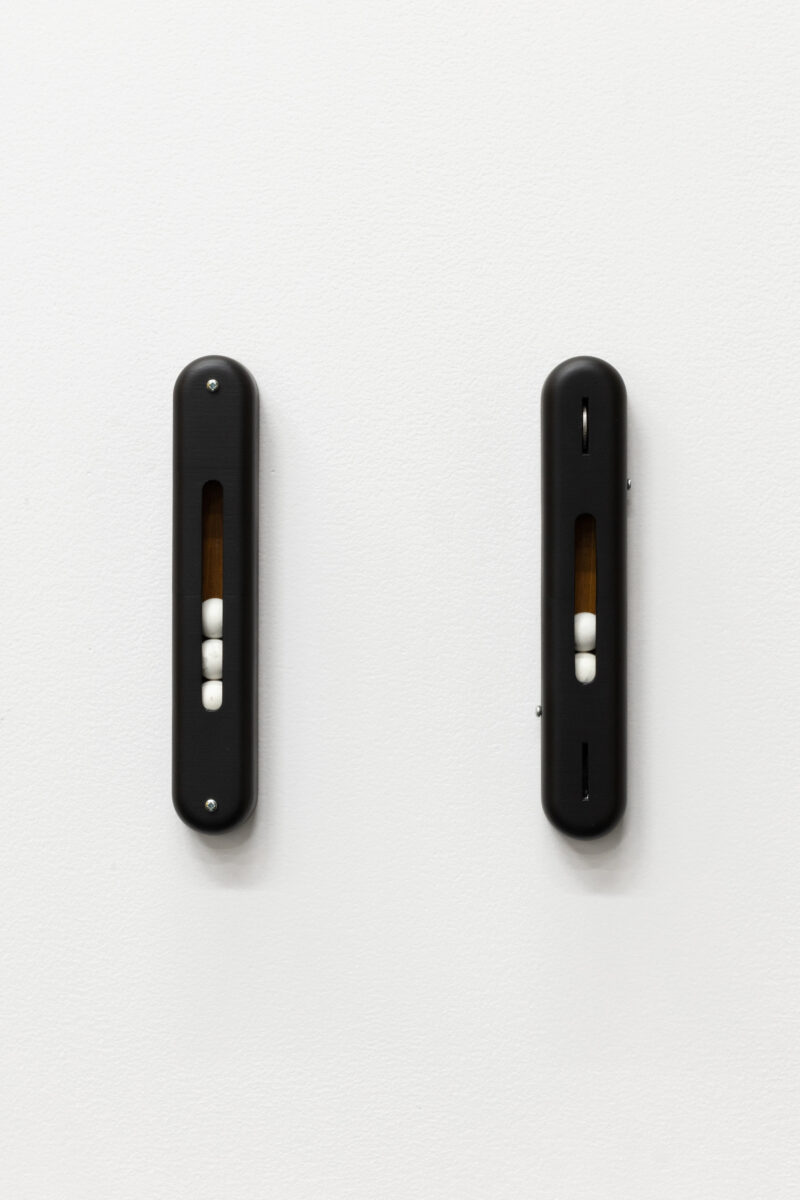
It sounds dumb, like a thick monotonous drone, a blue-grey mist perforated by dewy drips falling from ol’ pine trees. Lingering in The chase, one cannot escape the sound of Bichon’s first cartoon as it plays in a small anti-chamber. Titled, The Worst Caterpillar in the World (2023), the animation depicts a Pokemon-esque caterpillar — stylistically, a fat-thought bubble made green and cheekily disparaging with cherry-red hands — spot-lit by a circle of white light as if delivering a stand-up comedy routine. As the cartoon loops, this character delivers a logorrheic address:
We are “anti” and “out”.
Always.
We are always “against” and “outside”.
[…]
Where was I?
Oh, right.
Under the score.
Underscore.
Do you know its other names?
There are, in no particular order…
Low dash.
Underline.
Underscore character.
Low line.
In French, they can even say “white underline”.
I love it.
[…]
You, you believe in something.
But in practice, things are different for me.
[…]
I’m subject, object, complement.
All at once.
[…]
All of the above.
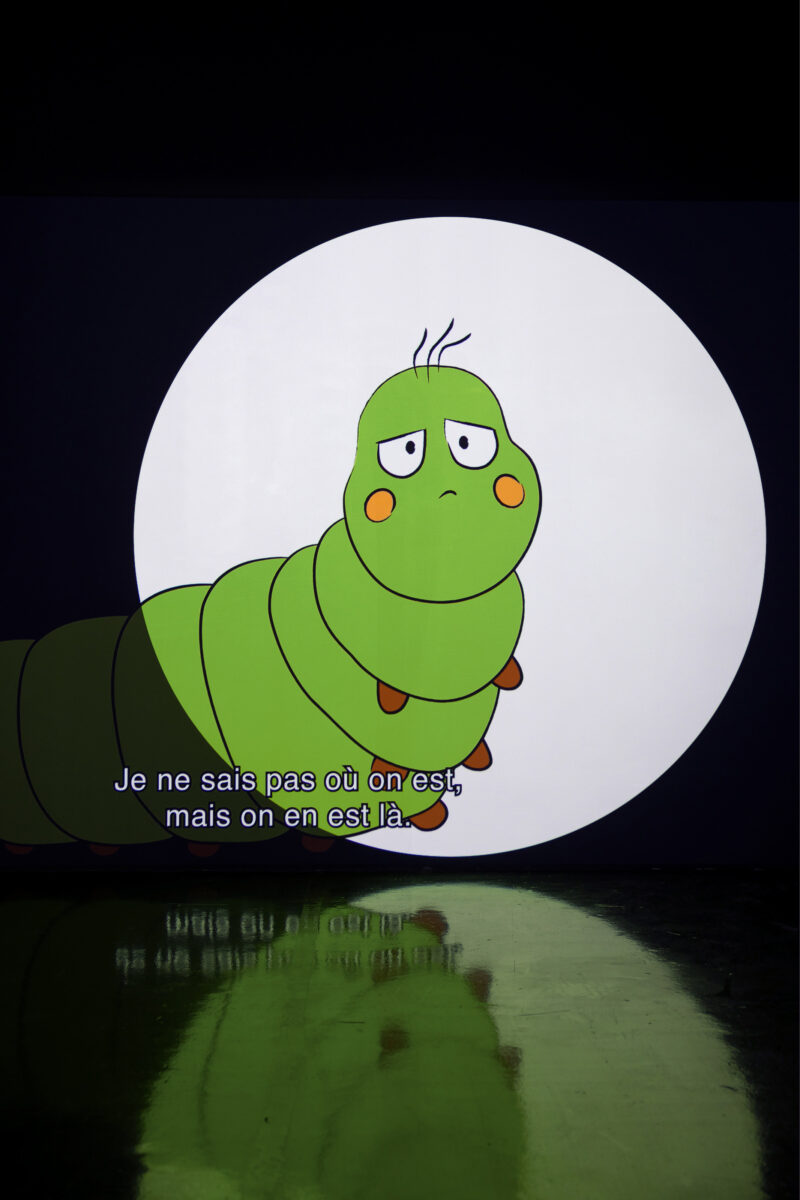
Something of a nihilistic skit, getting under the skin of the semantically set, this deadpan punnery, like much French theory, leaves me mentally running, unmoored and a tad confused. This sense of being lost in the thick of things does not detract from the work however, be this the cartoon or indeed the wider exhibition; it formally accentuates the affective journey of metamorphosis so central to Bichon’s thinking. Transitioning between narrations of its selfhood and meta-analysis of life’s structural frames, Bichon’s buggy protagonist conveys how a thing is a multi-tonal collection of parts, pasts and presences, influenced and informed by situations and surrounds. In other words, The Worst Caterpillar in the World, as with The chase more broadly, demonstrates how even the most mundane of things are never just ‘simply white’.
Maxime Bichon, La poursuite [The chase], Capc – Musée d’Art Contemporain de Bordeaux, until May 5th, 2024, capc-bordeaux.fr

